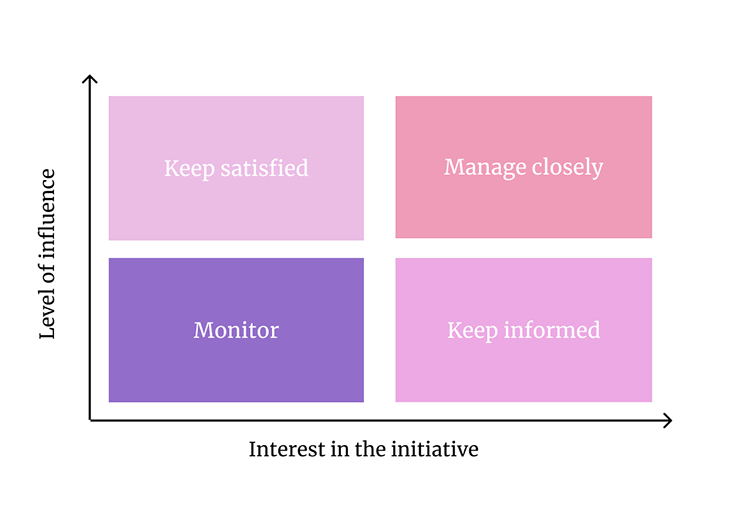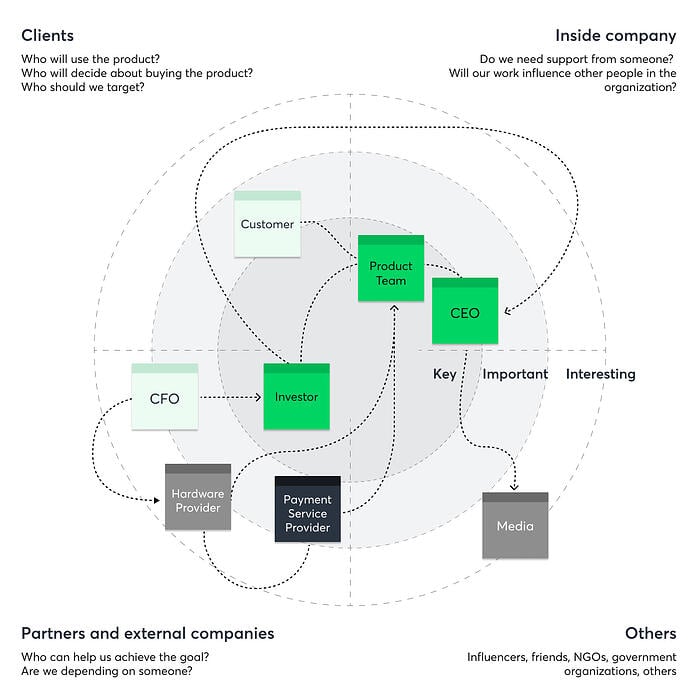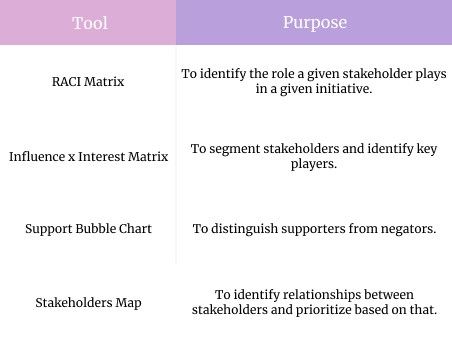Although stakeholder management isn’t the most glamorous part of the product management practice, it is one of its most critical components.

Contrary to popular belief, the PM is not the “CEO of the product.” They can’t just do whatever they want. More often than not, a PM needs buy-in from key players to get their initiatives moving.
In this article, we’ll dig deeper into the topic of stakeholder management.
I like to define stakeholder management as a “continuous process of getting support for initiatives while building healthy relationships and gaining influence.”
Let’s examine this definition step by step:
Since a product manager usually needs other people’s buy-in and is often expected to lead through influence, stakeholder management should be at the top of your priority list.
Great stakeholder management leads to resources, support, and even friendships. Poor stakeholder management might be a nail in the coffin of one’s career.
The general idea of stakeholder management is relatively straightforward. Keep people around you happy and on your side.
In smaller setups — when you have a handful of stakeholders to manage — you don’t really need any tools or specific strategies. Make sure to spend time with stakeholders, understand their needs, and maintain a healthy relationship with them. After that, you should be good to go.
It’s a different story when you have dozens of stakeholders on your radar or when you lead multiple initiatives with different sets of stakeholders. You need a more organized system to manage stakeholders in cases like that.
In the following section, we’ll go over how to identify types of stakeholders and how to identify the relationships between stakeholders. There are a few useful tools for managing stakeholders in a more complex setting, and we’ll go over them as well.
The first step in successful stakeholder management is identifying the types of stakeholders within your organization or project. You can do this in several ways, let’s jump into it.
The influence x interest matrix segments stakeholders into four buckets:

In general, stakeholders can be placed within the four quadrants shown on the map above.
While the influence x interest matrix is an excellent tool for stakeholder management, I find it slightly too excessive for most initiatives. I use a simplified version that distinguishes only two types of stakeholders:

Although the simplification brings some additional risks, over time, I learned that managing key players closely is 80 percent of the success of stakeholder management.
Regardless if you use the full version or a simplified one, make sure to update it regularly. Stakeholders’ levels of influence and interest change all the time. A distant stakeholder today might become your key player tomorrow.
You don’t only want to know how vital given stakeholders are, but also be able to group them based on their opinions regarding the initiative.
In most cases, you will have three types of stakeholders:

A bubble chart works great because it shows not only the given stakeholder’s opinion on the initiative (left-light alignment) but also their level of involvement (top-bottom alignment) and influence (bubble size).
Maximize the help you get from your top supporters, try to mitigate risks posed by top negators, and try to sway neutrals your way to maximize the chances of initiative success.
After you identify the types of stakeholders, it’s also important to see how these groups and individuals interact with the project, as well as with each other.
The responsibility assignment matrix, or RACI matrix, describes the relations of different stakeholders within a given initiative:

It distinguishes four types of relationships:
The RACI matrix works excellently as a transparency tool. If you keep it public, all stakeholders will see who does what for a project. It also works as a guardrail — you can always double-check if you have consulted all essential parties and if the information reaches all critical stakeholders.
You can use the RACI matrix to keep track of stakeholders whenever you have numerous expectations to manage.
The purpose of a stakeholder map is to identify relationships between stakeholders. After all, they don’t live in silos.
Different stakeholders have different levels of influence on other stakeholders. Sometimes, if you need the support of five other stakeholders, it might be easier to win the buy-in of their boss and then ask him to influence the rest.
Conversely, enraging one key player might lead to losing the support of half of the stakeholders. Some stakeholders impact others:

Map your most important stakeholders and their relation to other stakeholders. This will help you spot those few with the highest leverage and focus on them.
Even if you need buy-in from 100 people, sometimes all you need is to win a few of them; the rest will follow along.
This is a partial list of all stakeholder management tools, it’s by no means exhaustive. In the same vein, none of these tools is better than the others. Each tool serves a different purpose:

Depending on how precise you need your stakeholder management practice, you might want to use all of these tools simultaneously — each for different purposes — or none at all.
Stakeholder management is the bread and butter of product management practice. It leads to buy-in, and buy-in brings resources and support. To some extent, having stakeholder support is like fuel for a product manager. The more you have, the farther you can go.
Whether you decide to use a suite of complex tools and systems for managing stakeholders or just follow your gut feeling, always keep stakeholders in the back of your head.
Their support can make or break the whole initiative.
Featured image source: IconScout

LogRocket identifies friction points in the user experience so you can make informed decisions about product and design changes that must happen to hit your goals.
With LogRocket, you can understand the scope of the issues affecting your product and prioritize the changes that need to be made. LogRocket simplifies workflows by allowing Engineering, Product, UX, and Design teams to work from the same data as you, eliminating any confusion about what needs to be done.
Get your teams on the same page — try LogRocket today.

Promotions depend on proof. This guide shows PMs how to capture wins, feedback, and impact before review season.

Most teams fail at autonomy. Learn how clear rules help product teams move faster without micromanagement.

A practical framework for PMs to use AI in ideation without sacrificing judgment, strategy, or decision quality.

A practical five minute revenue estimation method to help product managers compare ideas, drop low impact features, and prioritize smarter.